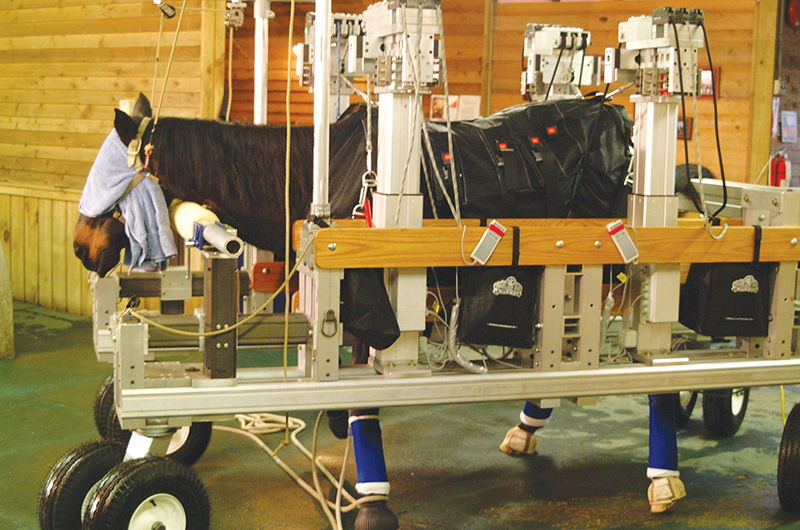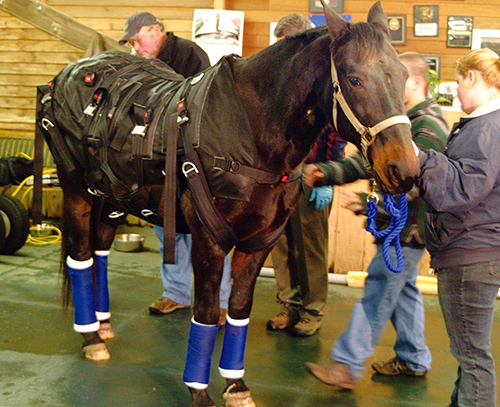
Robotic Joints Support Horses and Humans
Originating Technology/NASA Contribution
A rehabilitative device first featured in Spinoff 2003 is not only helping human patients regain the ability to walk, but is now helping our four-legged friends as well. The late James Kerley, a prominent Goddard Space Flight Center researcher, developed cable-compliant mechanisms in the 1980s to enable sounding rocket assemblies and robots to grip or join objects. In cable-compliant joints (CCJs), short segments of cable connect structural elements, allowing for six directions of movement, twisting, alignment, and energy damping.
Kerley later worked with Goddard’s Wayne Eklund and Allen Crane to incorporate the cable-compliant mechanisms into a walker for human patients to support the pelvis and imitate hip joint movement.
Partnership
In June 2002, Enduro Medical Technology, of South Windsor, Connecticut, licensed NASA’s cable-compliant technology and walker, and modified them into an advanced walker with a specialized, flexible harness that supports the torso. This eliminated the need for physical support from a therapist. According to Kenneth Messier, Enduro’s president, the company “saw using this cable-compliant mechanism as a way to really improve and revolutionize how physical therapy is done for patients.” The company designed four versions of its Secure Ambulation Module (S.A.M.), a device which provides a stable environment for patients during ambulation therapy. Enduro also introduced electronic linear actuators to give medical staff the ability to adjust and control the weight bearing of each patient, and a digital readout to record settings and track progress.
Enduro further developed the adjustable patient harness system, introducing S.A.M. in March 2003. The pelvic harness comes in various sizes and is padded with NASA-developed temper foam for comfort. The S.A.M. is currently in use for injured veterans at Walter Reed Army Medical Center, in Washington, DC, and the Edward Hines Jr. Veterans Administration Hospital, in Chicago. Kindred Hospital, in Greensboro, North Carolina, is using an institutional S.A.M. for patients weighing up to 1,000 pounds.
Product Outcome
In response to a request from the veterinary community, Enduro engineers developed a rehabilitative device for horses using the CCJ-technology in S.A.M. Enduro secured a license from Goddard in February 2007, to develop the Enduro N.E.S.T. (NASA Equine Support Technology). Enduro believes the N.E.S.T. will revolutionize veterinary equine medicine, opening the possibility for life saving surgery in horses that otherwise may have been euthanized. Like the S.A.M., the N.E.S.T. can adjust for height and width, accommodating horses of different sizes, from smaller horses weighing 1,000 pounds to draft horses weighing 2,400 pounds.
The N.E.S.T. reduces risk both before and after surgical procedures by supporting a horse’s weight. This also allows the anesthetized horse to remain upright, while traditional methods require the anesthetized horse be hoisted upside down by the legs for transportation into the surgical suite, which can cause a dangerous drop in the horse’s blood pressure. After surgery, horses need to stand as soon as possible after waking, since they cannot remain lying down for extended periods. When waking from anesthesia, horses are disoriented and unstable, frequently kicking and thrashing into the padded walls of their stall while attempting to stand. This frequently leads to broken limbs, concussions, and other injuries.
The only other options for a safer surgical recovery are padded recovery stalls and recovery pools, such as the one used for the racehorse Barbaro at the University of Pennsylvania. These treatments have drawbacks and are not appropriate for all cases: for instance, recovery pools require a large number of personnel and are expensive to build and maintain, and there are only two pools currently available in the United States for equine post-surgical recovery. These specially designed pools can cost over $1 million to construct; meanwhile, the N.E.S.T. will sell for $75,000 to $90,000.
A horse recovering from surgery in the N.E.S.T. is securely positioned in a natural standing position, which reduces complications, limits additional injuries to the horse, and protects both patients and staff from injury during and after procedures. “This equipment revolutionizes how horses recover from anesthesia immediately following surgery as well as allows long-term un-weighted rehabilitation,” said Messier. In the N.E.S.T., the horses remain calm, Messier explains. Conventional un-weighted therapies include underwater treadmills, rehabilitative swimming pools, and harnesses attached to permanent overhead lifts. With any water treatment, however, there is the potential for a dangerous infection if there are sutures from surgical procedures.
Traditionally, even after horses recover safely from surgery, they are still at risk of developing laminitis for months after an injury. One of most dangerous illnesses in horses, laminitis can occur when the “good” limb opposite the injured limb is forced to support too much weight. “The Enduro N.E.S.T. may help prevent the onset of this disease by selectively un-weighting different limbs,” says Messier, which is possible through the use of the cable-compliant joints developed at Goddard. The unit can balance weight individually for horses’ limbs instead of being weighted evenly or too heavily on one limb; Barbaro was eventually euthanized because of laminitis.
The N.E.S.T. can be used for extended periods of rehabilitation where the horse needs to stand in a controlled, secure environment. It can also be used at equine rehabilitation clinics, or brought to barns where the horses can be treated on site. Horses may even be able to reside permanently in the N.E.S.T.
Enduro continues to invest in further development and exploration of CCJ technology-based devices. A “Sit-To-Stand” version of S.A.M., also based on CCJ technology, is being used to help patients stand independently. The company has developed the S.A.M.-Y, a youth version for patients between 35 and 150 pounds and a maximum height of 5 feet 3 inches. Future Enduro plans call for the development of an adultversion of the S.A.M.
The S.A.M.™ and Enduro N.E.S.T.™ are trademarks of Enduro Inc.

An equine patient is fitted with a specialized, flexible harness that supports the torso.

The Enduro N.E.S.T. allows horses to remain standing during anesthesia or rehabilitation.













